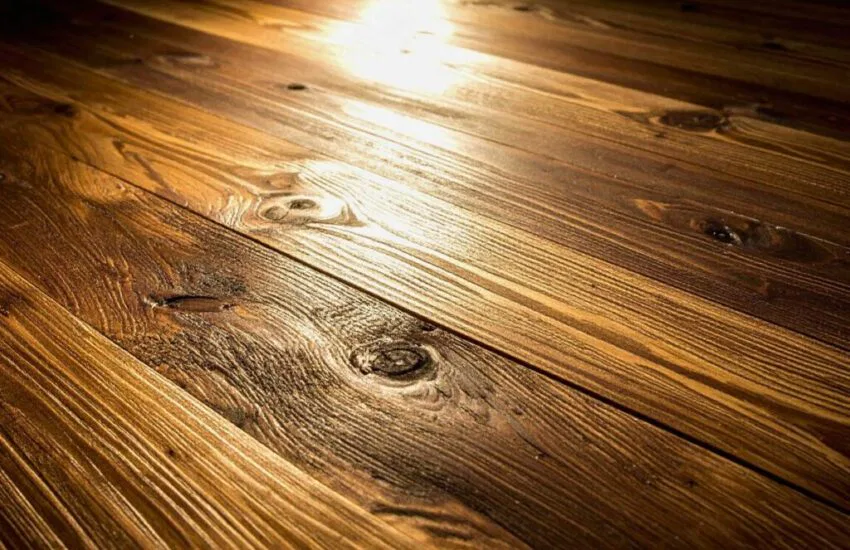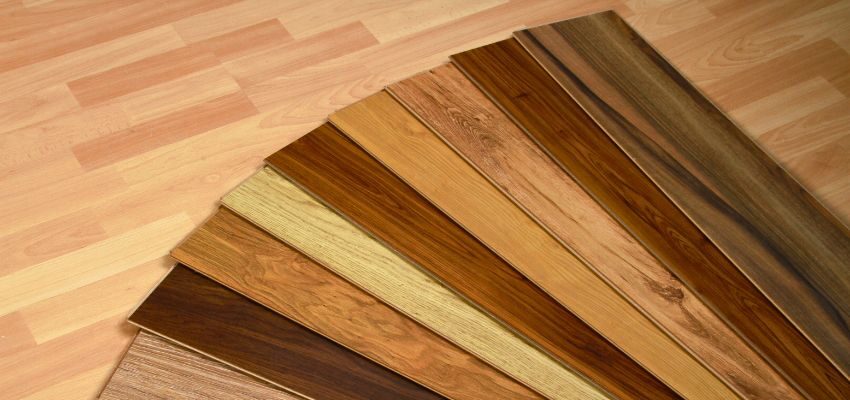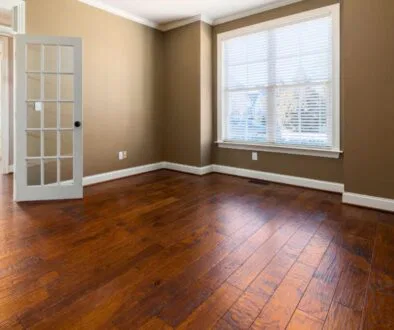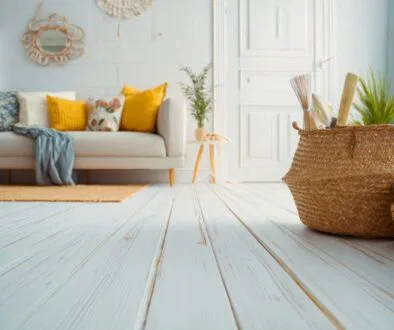Dark Wood Floors: Pros, Cons, And Care Tips You Should Know

Published November 12, 2025
Dreaming of a home with elegant, striking depth? Dark wood floors could be the secret, instantly elevating any space—from modern minimalist to classic traditional. Their rich tones offer a luxurious foundation that endures, transforming simple floors into design statements. But are they right for your space, or could their appeal conceal practical downsides?
In this article, we’ll examine the advantages and disadvantages of dark wood floors, care routines to keep them beautiful, and tips on achieving richer, darker finishes through staining.
What Are Dark Wood Floors?
Dark wood floors are a classic, versatile choice that brings warmth and character to any space. Their charm depends on key factors like wood type and finish.
Common Types Of Dark Wood Flooring
Dark wood floors feature deep, rich hues ranging from chocolate brown to near-black, achieved either naturally or through staining. Popular wood choices include:
- Walnut: Naturally dark and smooth, featuring elegant grain and deep brown hues.
- Oak: Durable and stains well, accommodating a wide range of dark finishes.
- Mahogany: Valued for its reddish-brown hue that deepens over time.
- Brazilian Cherry: A hard, luxurious wood that develops a deep, warm red hue with age.

Popular Shades And Finishes
Specific shades offer distinct tones:
- Espresso: Nearly black-brown, ideal for modern, dramatic spaces.
- Dark Walnut: A classic, warm tone suitable for both traditional and contemporary designs.
- Jacobean: A versatile dark brown with subtle warmth.
- Ebony: Deep black for bold, high-contrast interiors.
The finish determines both texture and sheen:
- Matte: Provides a natural look and hides minor marks.
- Gloss: Reflective and formal, highlighting grain detail.
- Hand-scraped: Offers a textured, rustic feel for an aged, artisanal appearance.
Natural Dark Woods Vs. Stained Floors
Natural dark woods (like walnut or mahogany) have consistent color throughout the plank, making scratches less noticeable. Stained floors, often lighter woods like oak or maple, have a colored surface layer. This means scratches can expose lighter tones underneath. However, staining offers more flexibility and affordability for custom shades.
The Pros Of Choosing Dark Wood Floors
Dark wood floors add visual appeal, elegance, character, and practical benefits to your home.
Elegant And Luxurious Appearance
The rich tones of dark wood create instant sophistication and timeless warmth for any style, from modern to vintage.
Highlights Decor And Architectural Details
Dark flooring acts as a visual anchor that makes light-colored walls, furniture, and trim stand out. This contrast emphasizes architectural features like moldings and built-ins, giving rooms a crisp, balanced feel.
Conceals Minor Imperfections
Dark stains and natural grains can help disguise small gaps, dents, and everyday wear, making these floors both stylish and practical for busy households.
The Cons Of Dark Wood Floors
Despite their stylish appeal, dark wood floors come with a few challenges.
Shows Dust And Pet Hair Easily
Dust, pet hair, and other light-colored debris are more visible against a dark surface, meaning you’ll need to clean more often to keep them looking their best. A quick daily sweep with a microfiber mop or vacuum can help.
Can Make Small Spaces Feel Smaller
Dark tones absorb light, making small rooms cozy but sometimes cramped. Pair dark floors with light walls, airy curtains, and mirrors to balance the effect.
Scratches Are More Visible
Scratches that expose the lighter wood underneath are more noticeable on dark finishes. Using felt pads on furniture, placing area rugs in high-traffic zones, and choosing a satin or matte finish can help minimize their appearance.

How To Care For Dark Wood Floors And Keep Them Looking Stunning
Regular Cleaning And Maintenance Routine
Because dark floors show dust easily, regular cleaning is essential. Use a microfiber mop or vacuum with a soft brush for daily upkeep, and a pH-neutral floor cleaner when needed—never soak the wood or use harsh chemicals.
Preventive Measures To Reduce Damage
Prevent damage before it starts:
- Position doormats at entryways to trap dirt and grit.
- Add area rugs and runners in high-traffic zones.
- Attach felt pads under all furniture legs.
- Maintain indoor humidity between 35-55%.
- Protect from UV exposure with curtains or window films.
Refinishing And Restoration Tips
Even with proper care, floors eventually lose their luster. Refinishing—sanding away the old finish and applying a new coat—restores their depth and shine. For minor wear, a simple screening and recoating might suffice. Generally, plan to refinish every 7-10 years, depending on traffic and finish quality.
How To Stain Hardwood Floors Darker For A Richer Look
Darkening existing hardwood floors can transform your space without replacement. Success, however, relies on proper preparation and technique.
Choosing The Right Stain Color And Finish
Choose a shade that suits your home’s decor and lighting. Popular dark stain options like Espresso, Jacobean, and Dark Walnut add depth and sophistication. Always test your chosen stain on a small, hidden area first to preview the final color.
If you’re starting from scratch or replacing old boards, explore Vintage & Specialty Wood’s curated collection of reclaimed hardwoods — ideal for deeper staining and timeless elegance.
Step-By-Step Guide To Staining Hardwood Floors Darker
- Preparation: Clear the room, protect the walls and vents, and ensure the floor is free of dust and debris.
- Sanding: Sand off the old finish, starting coarse and finishing fine, to open wood pores for even absorption and a smooth surface.
- Application: Apply stain evenly with a brush or cloth, following the wood grain. Wipe excess immediately and allow it to dry.
- Sealing: Once dry, apply 2-3 coats of polyurethane, sanding lightly between layers for a durable, smooth finish.
Common Mistakes To Avoid
Work in small, consistent sections to avoid uneven coverage or overlapping stains. Incomplete sanding or leftover dust can also cause blotchiness. When in doubt, consider hiring a professional for a flawless, long-lasting result.
Frequently Asked Questions
Are dark wood floors harder to maintain than light ones?
Dark floors show dust more easily. However, regular cleaning with a microfiber mop and gentle hardwood cleaner makes maintenance simple.
Do dark floors make a room look smaller?
Darker tones can make a room feel smaller because they absorb light. However, you can create a cozy yet open atmosphere by balancing them with light-colored walls and ample lighting.
How often should you refinish dark hardwood floors?
Typically, floors need refinishing every 7–10 years, depending on wear and traffic. Minor dullness or surface scratches can often be fixed with a light screening and recoating.
Can you stain existing hardwood floors darker without sanding?
No, not effectively. The existing finish block stain penetration. Sanding is essential for even, lasting results when applying a darker stain.
What’s the best finish for dark wood floors to prevent scratches?
A matte or satin finish is ideal. Their low sheen minimizes dust and scuffs, maintaining an elegant look.

Is It Time To Embrace The Beauty Of Dark Wood Floors?
Dark wood floors deliver timeless elegance and contrast but require consistent care. If you appreciate dramatic style and can manage extra upkeep, they’re a lasting investment. Choose the right finish and protect it daily for years of beauty.
Ready to find your dream flooring? Vintage & Specialty Wood offers a curated collection of reclaimed and specialty hardwoods, each with unique character and history. Whether you want a naturally dark wood or a custom-stained masterpiece, their selection can help you transform your space with timeless charm.
Hire The Timber Experts For Your Next Project
Vintage & Specialty Wood should be your source of the highest quality timbers from around the world. When it comes to fabricating and installing reclaimed wood or specialty wood products in your home, we don’t cut corners. We offer many reclaimed wood and specialty wood products such as Douglas Fir, white oak, and much more. We also offer timber framing and wood flooring services as well. Contact our team today to speak to a timber expert about what Vintage & Specialty Wood can do for you.

This Blog Is Fact Checked
This content has undergone meticulous fact-checking by our team of internal experts. Gain a deeper understanding of the high editorial standards we uphold on our website here.

About The Author
Experience, exploration, and knowledge are the hallmarks of writer Rei Bayucca. Her dedication to crafting articles that both inspire and educate will leave you thinking long after you’ve finished reading.




